Business Law Report: Business Law and Kango Company Dispute Resolution
VerifiedAdded on 2021/01/03
|12
|3155
|34
Report
AI Summary
This report provides a comprehensive overview of business law, focusing on the UK legal system and its impact on businesses. It examines key aspects such as the nature of the legal system, the potential impact of law on business operations, and the formation of different business organization types including sole proprietorships, limited companies, and partnerships. The report uses a case study of Kango, a meal delivery company, to illustrate the practical application of legal principles, particularly concerning employment law and the classification of workers. It delves into the legal implications of treating couriers as self-employed versus employees, drawing parallels with cases like Uber and Pimlico Plumbers. Furthermore, the report suggests legal solutions for Kango to resolve its key areas of dispute and comply with relevant legislation, emphasizing the importance of understanding labor laws, taxation policies, and the implications of the Affordable Care Act. The report also outlines the steps involved in forming a sole proprietorship, offering a practical guide for entrepreneurs.
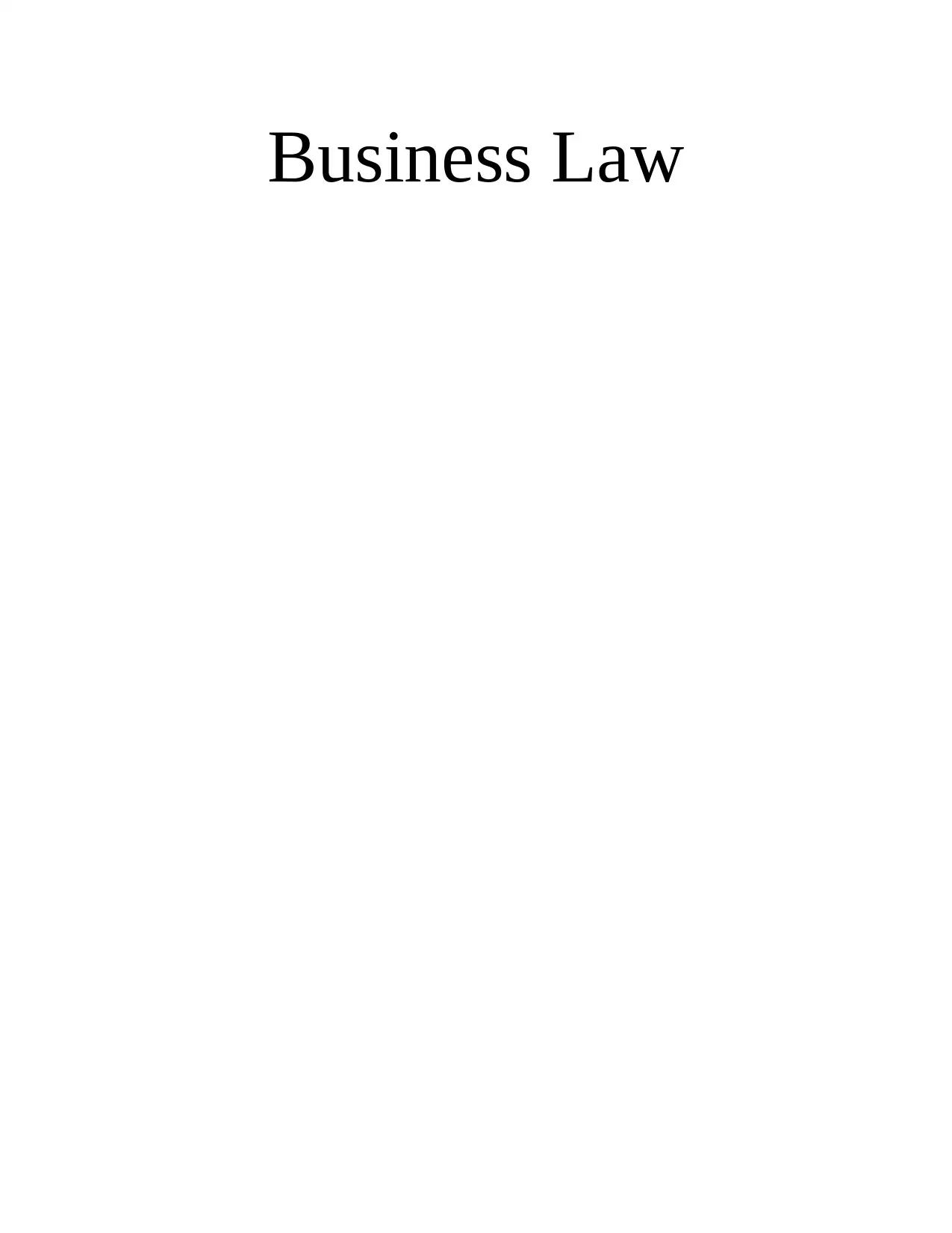
Business Law
Paraphrase This Document
Need a fresh take? Get an instant paraphrase of this document with our AI Paraphraser
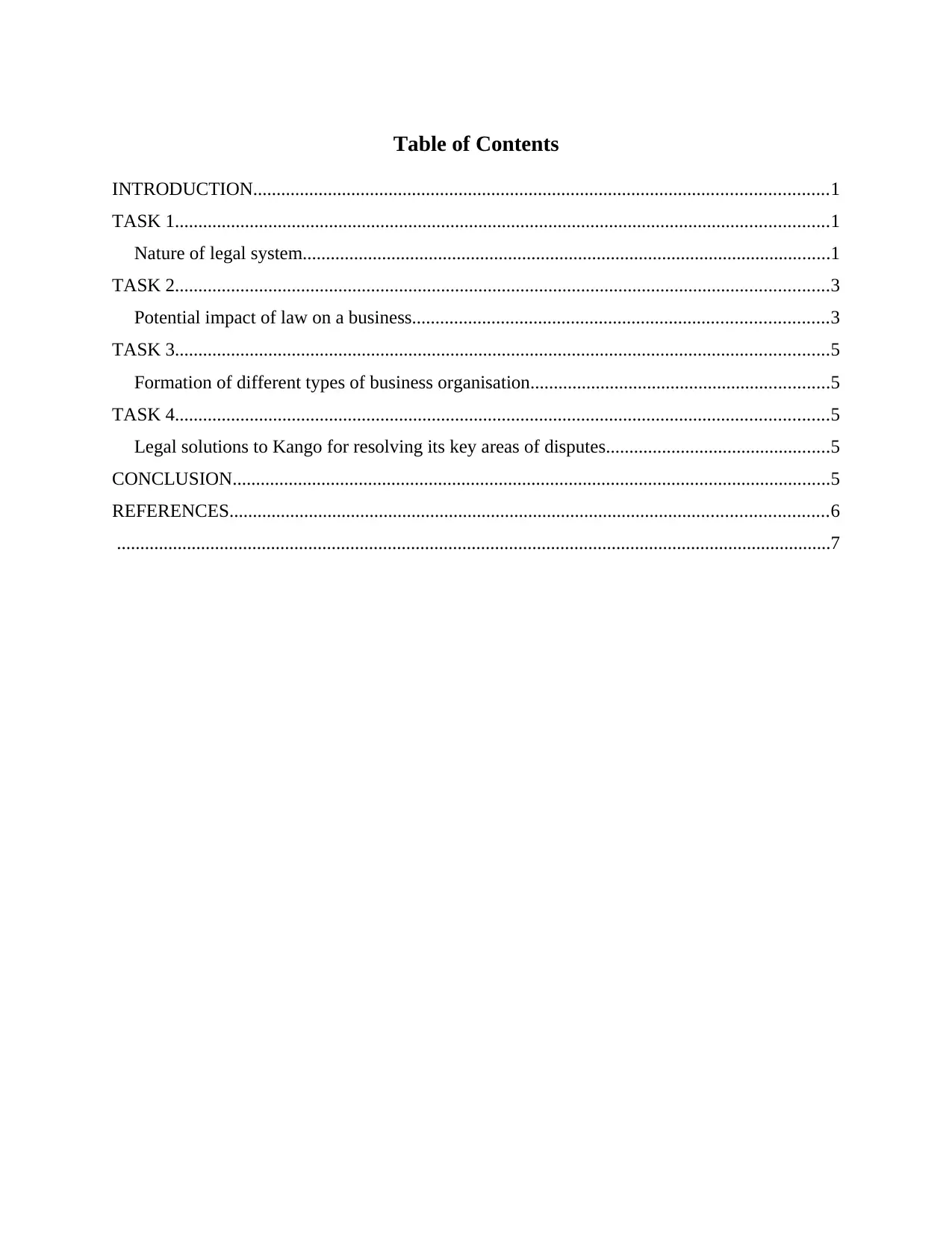
Table of Contents
INTRODUCTION...........................................................................................................................1
TASK 1............................................................................................................................................1
Nature of legal system.................................................................................................................1
TASK 2............................................................................................................................................3
Potential impact of law on a business.........................................................................................3
TASK 3............................................................................................................................................5
Formation of different types of business organisation................................................................5
TASK 4............................................................................................................................................5
Legal solutions to Kango for resolving its key areas of disputes................................................5
CONCLUSION................................................................................................................................5
REFERENCES................................................................................................................................6
.........................................................................................................................................................7
INTRODUCTION...........................................................................................................................1
TASK 1............................................................................................................................................1
Nature of legal system.................................................................................................................1
TASK 2............................................................................................................................................3
Potential impact of law on a business.........................................................................................3
TASK 3............................................................................................................................................5
Formation of different types of business organisation................................................................5
TASK 4............................................................................................................................................5
Legal solutions to Kango for resolving its key areas of disputes................................................5
CONCLUSION................................................................................................................................5
REFERENCES................................................................................................................................6
.........................................................................................................................................................7

⊘ This is a preview!⊘
Do you want full access?
Subscribe today to unlock all pages.

Trusted by 1+ million students worldwide
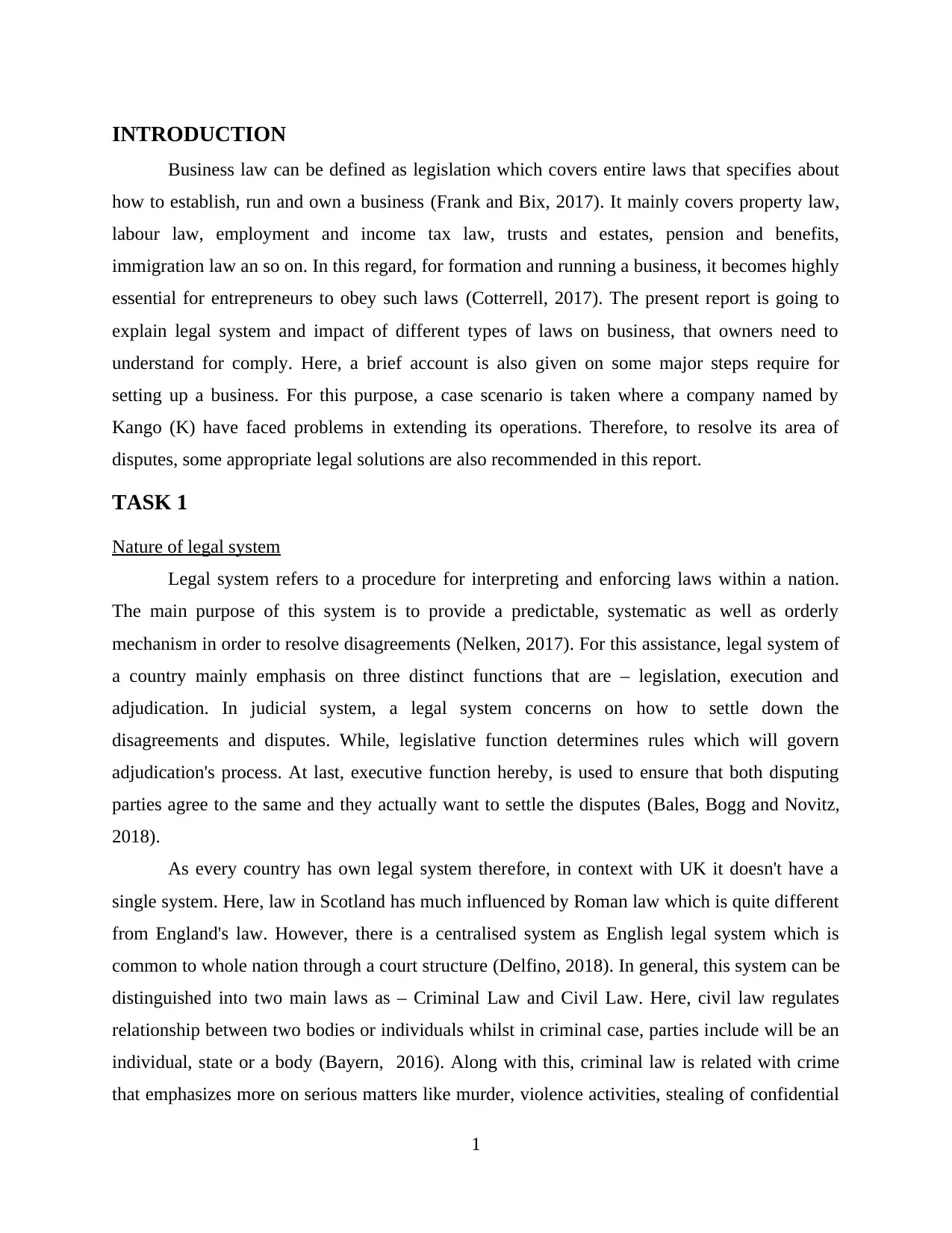
INTRODUCTION
Business law can be defined as legislation which covers entire laws that specifies about
how to establish, run and own a business (Frank and Bix, 2017). It mainly covers property law,
labour law, employment and income tax law, trusts and estates, pension and benefits,
immigration law an so on. In this regard, for formation and running a business, it becomes highly
essential for entrepreneurs to obey such laws (Cotterrell, 2017). The present report is going to
explain legal system and impact of different types of laws on business, that owners need to
understand for comply. Here, a brief account is also given on some major steps require for
setting up a business. For this purpose, a case scenario is taken where a company named by
Kango (K) have faced problems in extending its operations. Therefore, to resolve its area of
disputes, some appropriate legal solutions are also recommended in this report.
TASK 1
Nature of legal system
Legal system refers to a procedure for interpreting and enforcing laws within a nation.
The main purpose of this system is to provide a predictable, systematic as well as orderly
mechanism in order to resolve disagreements (Nelken, 2017). For this assistance, legal system of
a country mainly emphasis on three distinct functions that are – legislation, execution and
adjudication. In judicial system, a legal system concerns on how to settle down the
disagreements and disputes. While, legislative function determines rules which will govern
adjudication's process. At last, executive function hereby, is used to ensure that both disputing
parties agree to the same and they actually want to settle the disputes (Bales, Bogg and Novitz,
2018).
As every country has own legal system therefore, in context with UK it doesn't have a
single system. Here, law in Scotland has much influenced by Roman law which is quite different
from England's law. However, there is a centralised system as English legal system which is
common to whole nation through a court structure (Delfino, 2018). In general, this system can be
distinguished into two main laws as – Criminal Law and Civil Law. Here, civil law regulates
relationship between two bodies or individuals whilst in criminal case, parties include will be an
individual, state or a body (Bayern, 2016). Along with this, criminal law is related with crime
that emphasizes more on serious matters like murder, violence activities, stealing of confidential
1
Business law can be defined as legislation which covers entire laws that specifies about
how to establish, run and own a business (Frank and Bix, 2017). It mainly covers property law,
labour law, employment and income tax law, trusts and estates, pension and benefits,
immigration law an so on. In this regard, for formation and running a business, it becomes highly
essential for entrepreneurs to obey such laws (Cotterrell, 2017). The present report is going to
explain legal system and impact of different types of laws on business, that owners need to
understand for comply. Here, a brief account is also given on some major steps require for
setting up a business. For this purpose, a case scenario is taken where a company named by
Kango (K) have faced problems in extending its operations. Therefore, to resolve its area of
disputes, some appropriate legal solutions are also recommended in this report.
TASK 1
Nature of legal system
Legal system refers to a procedure for interpreting and enforcing laws within a nation.
The main purpose of this system is to provide a predictable, systematic as well as orderly
mechanism in order to resolve disagreements (Nelken, 2017). For this assistance, legal system of
a country mainly emphasis on three distinct functions that are – legislation, execution and
adjudication. In judicial system, a legal system concerns on how to settle down the
disagreements and disputes. While, legislative function determines rules which will govern
adjudication's process. At last, executive function hereby, is used to ensure that both disputing
parties agree to the same and they actually want to settle the disputes (Bales, Bogg and Novitz,
2018).
As every country has own legal system therefore, in context with UK it doesn't have a
single system. Here, law in Scotland has much influenced by Roman law which is quite different
from England's law. However, there is a centralised system as English legal system which is
common to whole nation through a court structure (Delfino, 2018). In general, this system can be
distinguished into two main laws as – Criminal Law and Civil Law. Here, civil law regulates
relationship between two bodies or individuals whilst in criminal case, parties include will be an
individual, state or a body (Bayern, 2016). Along with this, criminal law is related with crime
that emphasizes more on serious matters like murder, violence activities, stealing of confidential
1
Paraphrase This Document
Need a fresh take? Get an instant paraphrase of this document with our AI Paraphraser
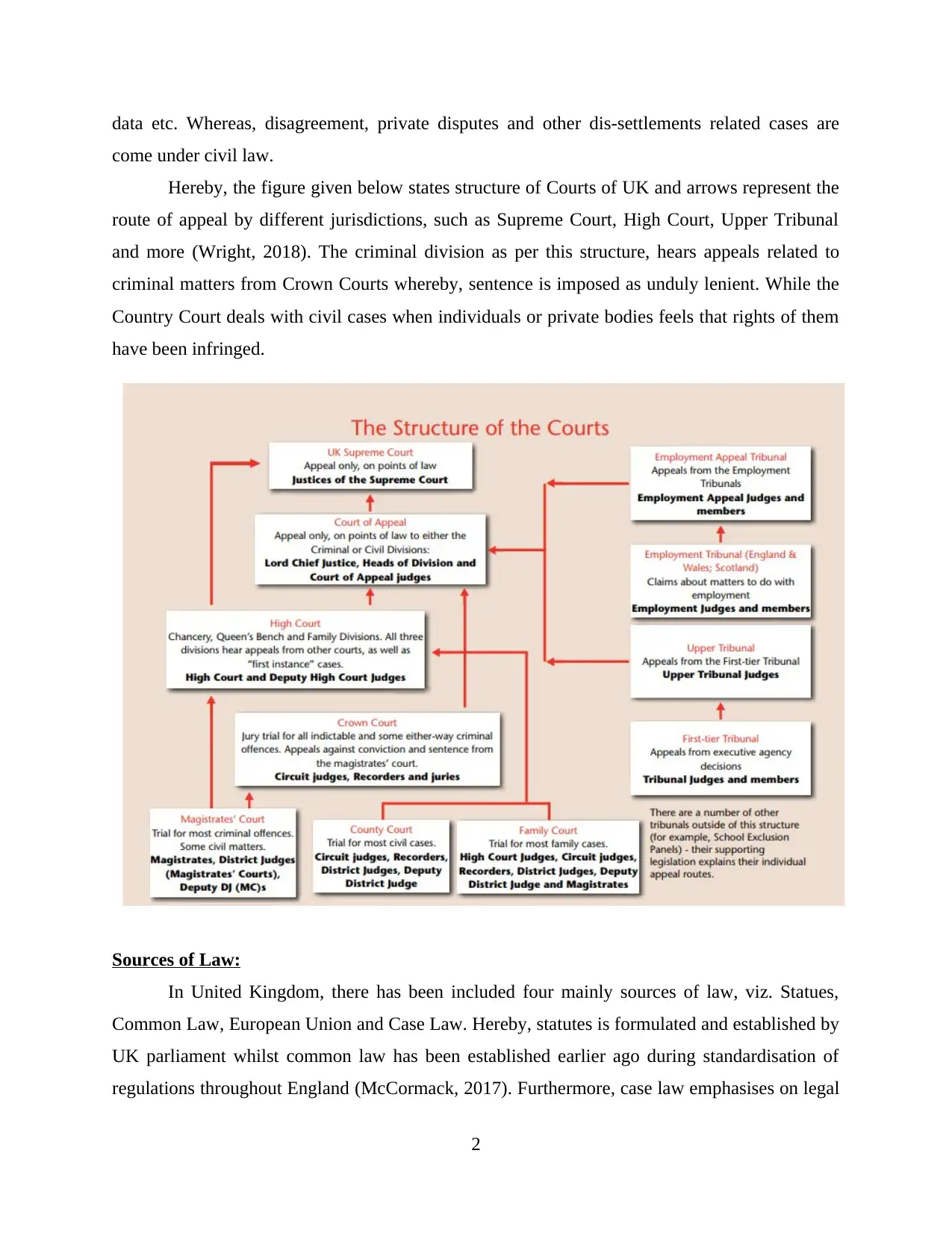
data etc. Whereas, disagreement, private disputes and other dis-settlements related cases are
come under civil law.
Hereby, the figure given below states structure of Courts of UK and arrows represent the
route of appeal by different jurisdictions, such as Supreme Court, High Court, Upper Tribunal
and more (Wright, 2018). The criminal division as per this structure, hears appeals related to
criminal matters from Crown Courts whereby, sentence is imposed as unduly lenient. While the
Country Court deals with civil cases when individuals or private bodies feels that rights of them
have been infringed.
Sources of Law:
In United Kingdom, there has been included four mainly sources of law, viz. Statues,
Common Law, European Union and Case Law. Hereby, statutes is formulated and established by
UK parliament whilst common law has been established earlier ago during standardisation of
regulations throughout England (McCormack, 2017). Furthermore, case law emphasises on legal
2
come under civil law.
Hereby, the figure given below states structure of Courts of UK and arrows represent the
route of appeal by different jurisdictions, such as Supreme Court, High Court, Upper Tribunal
and more (Wright, 2018). The criminal division as per this structure, hears appeals related to
criminal matters from Crown Courts whereby, sentence is imposed as unduly lenient. While the
Country Court deals with civil cases when individuals or private bodies feels that rights of them
have been infringed.
Sources of Law:
In United Kingdom, there has been included four mainly sources of law, viz. Statues,
Common Law, European Union and Case Law. Hereby, statutes is formulated and established by
UK parliament whilst common law has been established earlier ago during standardisation of
regulations throughout England (McCormack, 2017). Furthermore, case law emphasises on legal
2
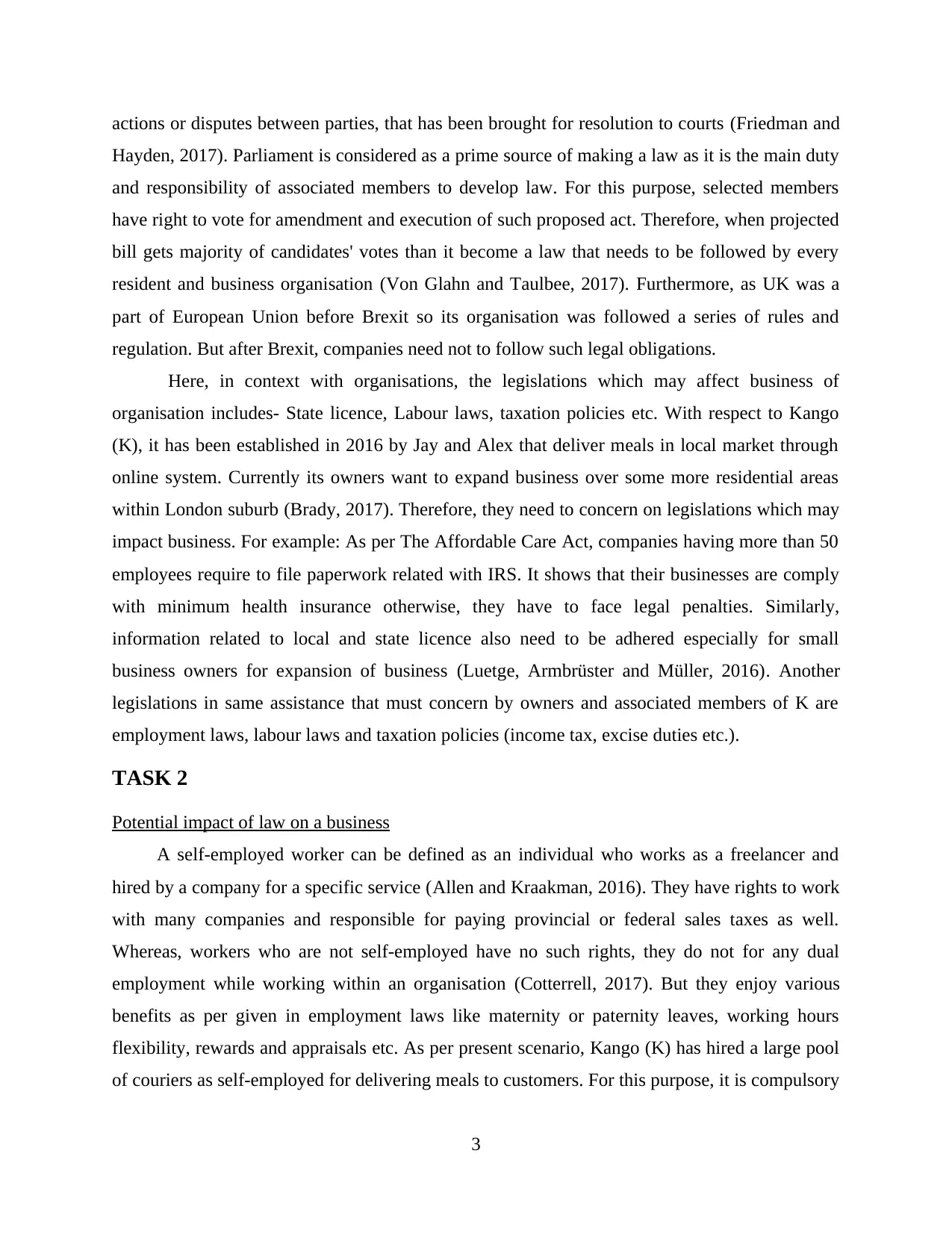
actions or disputes between parties, that has been brought for resolution to courts (Friedman and
Hayden, 2017). Parliament is considered as a prime source of making a law as it is the main duty
and responsibility of associated members to develop law. For this purpose, selected members
have right to vote for amendment and execution of such proposed act. Therefore, when projected
bill gets majority of candidates' votes than it become a law that needs to be followed by every
resident and business organisation (Von Glahn and Taulbee, 2017). Furthermore, as UK was a
part of European Union before Brexit so its organisation was followed a series of rules and
regulation. But after Brexit, companies need not to follow such legal obligations.
Here, in context with organisations, the legislations which may affect business of
organisation includes- State licence, Labour laws, taxation policies etc. With respect to Kango
(K), it has been established in 2016 by Jay and Alex that deliver meals in local market through
online system. Currently its owners want to expand business over some more residential areas
within London suburb (Brady, 2017). Therefore, they need to concern on legislations which may
impact business. For example: As per The Affordable Care Act, companies having more than 50
employees require to file paperwork related with IRS. It shows that their businesses are comply
with minimum health insurance otherwise, they have to face legal penalties. Similarly,
information related to local and state licence also need to be adhered especially for small
business owners for expansion of business (Luetge, Armbrüster and Müller, 2016). Another
legislations in same assistance that must concern by owners and associated members of K are
employment laws, labour laws and taxation policies (income tax, excise duties etc.).
TASK 2
Potential impact of law on a business
A self-employed worker can be defined as an individual who works as a freelancer and
hired by a company for a specific service (Allen and Kraakman, 2016). They have rights to work
with many companies and responsible for paying provincial or federal sales taxes as well.
Whereas, workers who are not self-employed have no such rights, they do not for any dual
employment while working within an organisation (Cotterrell, 2017). But they enjoy various
benefits as per given in employment laws like maternity or paternity leaves, working hours
flexibility, rewards and appraisals etc. As per present scenario, Kango (K) has hired a large pool
of couriers as self-employed for delivering meals to customers. For this purpose, it is compulsory
3
Hayden, 2017). Parliament is considered as a prime source of making a law as it is the main duty
and responsibility of associated members to develop law. For this purpose, selected members
have right to vote for amendment and execution of such proposed act. Therefore, when projected
bill gets majority of candidates' votes than it become a law that needs to be followed by every
resident and business organisation (Von Glahn and Taulbee, 2017). Furthermore, as UK was a
part of European Union before Brexit so its organisation was followed a series of rules and
regulation. But after Brexit, companies need not to follow such legal obligations.
Here, in context with organisations, the legislations which may affect business of
organisation includes- State licence, Labour laws, taxation policies etc. With respect to Kango
(K), it has been established in 2016 by Jay and Alex that deliver meals in local market through
online system. Currently its owners want to expand business over some more residential areas
within London suburb (Brady, 2017). Therefore, they need to concern on legislations which may
impact business. For example: As per The Affordable Care Act, companies having more than 50
employees require to file paperwork related with IRS. It shows that their businesses are comply
with minimum health insurance otherwise, they have to face legal penalties. Similarly,
information related to local and state licence also need to be adhered especially for small
business owners for expansion of business (Luetge, Armbrüster and Müller, 2016). Another
legislations in same assistance that must concern by owners and associated members of K are
employment laws, labour laws and taxation policies (income tax, excise duties etc.).
TASK 2
Potential impact of law on a business
A self-employed worker can be defined as an individual who works as a freelancer and
hired by a company for a specific service (Allen and Kraakman, 2016). They have rights to work
with many companies and responsible for paying provincial or federal sales taxes as well.
Whereas, workers who are not self-employed have no such rights, they do not for any dual
employment while working within an organisation (Cotterrell, 2017). But they enjoy various
benefits as per given in employment laws like maternity or paternity leaves, working hours
flexibility, rewards and appraisals etc. As per present scenario, Kango (K) has hired a large pool
of couriers as self-employed for delivering meals to customers. For this purpose, it is compulsory
3
⊘ This is a preview!⊘
Do you want full access?
Subscribe today to unlock all pages.

Trusted by 1+ million students worldwide
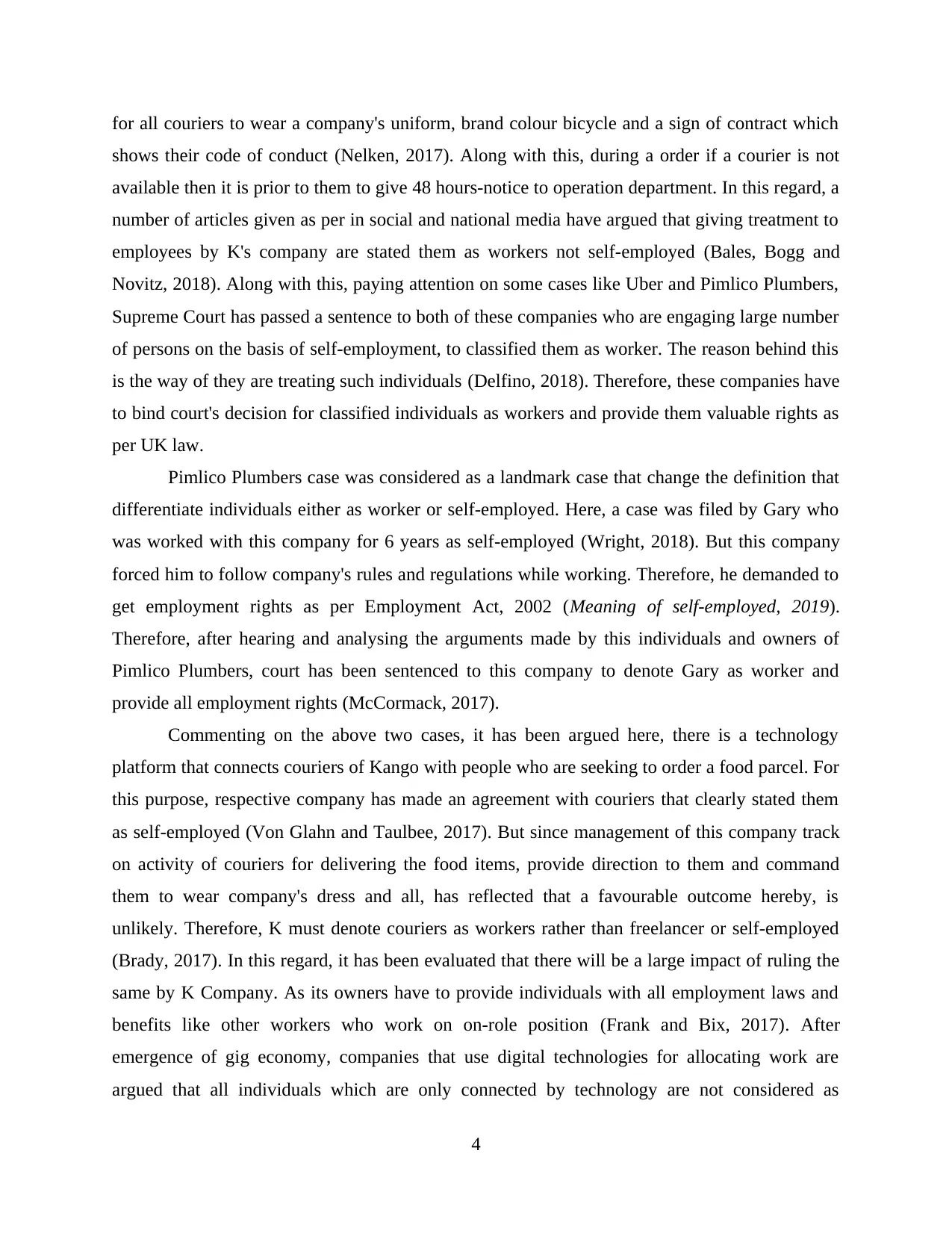
for all couriers to wear a company's uniform, brand colour bicycle and a sign of contract which
shows their code of conduct (Nelken, 2017). Along with this, during a order if a courier is not
available then it is prior to them to give 48 hours-notice to operation department. In this regard, a
number of articles given as per in social and national media have argued that giving treatment to
employees by K's company are stated them as workers not self-employed (Bales, Bogg and
Novitz, 2018). Along with this, paying attention on some cases like Uber and Pimlico Plumbers,
Supreme Court has passed a sentence to both of these companies who are engaging large number
of persons on the basis of self-employment, to classified them as worker. The reason behind this
is the way of they are treating such individuals (Delfino, 2018). Therefore, these companies have
to bind court's decision for classified individuals as workers and provide them valuable rights as
per UK law.
Pimlico Plumbers case was considered as a landmark case that change the definition that
differentiate individuals either as worker or self-employed. Here, a case was filed by Gary who
was worked with this company for 6 years as self-employed (Wright, 2018). But this company
forced him to follow company's rules and regulations while working. Therefore, he demanded to
get employment rights as per Employment Act, 2002 (Meaning of self-employed, 2019).
Therefore, after hearing and analysing the arguments made by this individuals and owners of
Pimlico Plumbers, court has been sentenced to this company to denote Gary as worker and
provide all employment rights (McCormack, 2017).
Commenting on the above two cases, it has been argued here, there is a technology
platform that connects couriers of Kango with people who are seeking to order a food parcel. For
this purpose, respective company has made an agreement with couriers that clearly stated them
as self-employed (Von Glahn and Taulbee, 2017). But since management of this company track
on activity of couriers for delivering the food items, provide direction to them and command
them to wear company's dress and all, has reflected that a favourable outcome hereby, is
unlikely. Therefore, K must denote couriers as workers rather than freelancer or self-employed
(Brady, 2017). In this regard, it has been evaluated that there will be a large impact of ruling the
same by K Company. As its owners have to provide individuals with all employment laws and
benefits like other workers who work on on-role position (Frank and Bix, 2017). After
emergence of gig economy, companies that use digital technologies for allocating work are
argued that all individuals which are only connected by technology are not considered as
4
shows their code of conduct (Nelken, 2017). Along with this, during a order if a courier is not
available then it is prior to them to give 48 hours-notice to operation department. In this regard, a
number of articles given as per in social and national media have argued that giving treatment to
employees by K's company are stated them as workers not self-employed (Bales, Bogg and
Novitz, 2018). Along with this, paying attention on some cases like Uber and Pimlico Plumbers,
Supreme Court has passed a sentence to both of these companies who are engaging large number
of persons on the basis of self-employment, to classified them as worker. The reason behind this
is the way of they are treating such individuals (Delfino, 2018). Therefore, these companies have
to bind court's decision for classified individuals as workers and provide them valuable rights as
per UK law.
Pimlico Plumbers case was considered as a landmark case that change the definition that
differentiate individuals either as worker or self-employed. Here, a case was filed by Gary who
was worked with this company for 6 years as self-employed (Wright, 2018). But this company
forced him to follow company's rules and regulations while working. Therefore, he demanded to
get employment rights as per Employment Act, 2002 (Meaning of self-employed, 2019).
Therefore, after hearing and analysing the arguments made by this individuals and owners of
Pimlico Plumbers, court has been sentenced to this company to denote Gary as worker and
provide all employment rights (McCormack, 2017).
Commenting on the above two cases, it has been argued here, there is a technology
platform that connects couriers of Kango with people who are seeking to order a food parcel. For
this purpose, respective company has made an agreement with couriers that clearly stated them
as self-employed (Von Glahn and Taulbee, 2017). But since management of this company track
on activity of couriers for delivering the food items, provide direction to them and command
them to wear company's dress and all, has reflected that a favourable outcome hereby, is
unlikely. Therefore, K must denote couriers as workers rather than freelancer or self-employed
(Brady, 2017). In this regard, it has been evaluated that there will be a large impact of ruling the
same by K Company. As its owners have to provide individuals with all employment laws and
benefits like other workers who work on on-role position (Frank and Bix, 2017). After
emergence of gig economy, companies that use digital technologies for allocating work are
argued that all individuals which are only connected by technology are not considered as
4
Paraphrase This Document
Need a fresh take? Get an instant paraphrase of this document with our AI Paraphraser
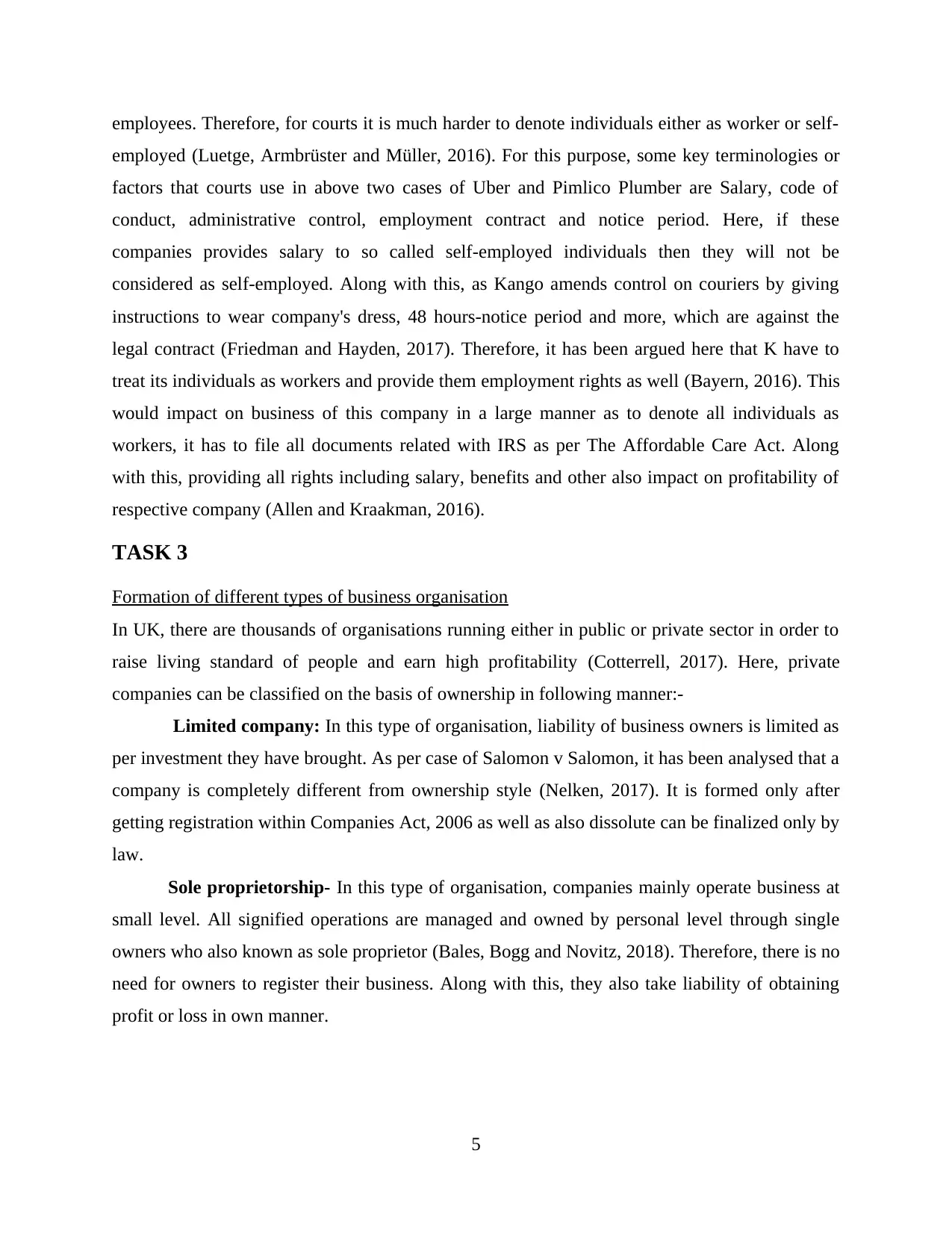
employees. Therefore, for courts it is much harder to denote individuals either as worker or self-
employed (Luetge, Armbrüster and Müller, 2016). For this purpose, some key terminologies or
factors that courts use in above two cases of Uber and Pimlico Plumber are Salary, code of
conduct, administrative control, employment contract and notice period. Here, if these
companies provides salary to so called self-employed individuals then they will not be
considered as self-employed. Along with this, as Kango amends control on couriers by giving
instructions to wear company's dress, 48 hours-notice period and more, which are against the
legal contract (Friedman and Hayden, 2017). Therefore, it has been argued here that K have to
treat its individuals as workers and provide them employment rights as well (Bayern, 2016). This
would impact on business of this company in a large manner as to denote all individuals as
workers, it has to file all documents related with IRS as per The Affordable Care Act. Along
with this, providing all rights including salary, benefits and other also impact on profitability of
respective company (Allen and Kraakman, 2016).
TASK 3
Formation of different types of business organisation
In UK, there are thousands of organisations running either in public or private sector in order to
raise living standard of people and earn high profitability (Cotterrell, 2017). Here, private
companies can be classified on the basis of ownership in following manner:-
Limited company: In this type of organisation, liability of business owners is limited as
per investment they have brought. As per case of Salomon v Salomon, it has been analysed that a
company is completely different from ownership style (Nelken, 2017). It is formed only after
getting registration within Companies Act, 2006 as well as also dissolute can be finalized only by
law.
Sole proprietorship- In this type of organisation, companies mainly operate business at
small level. All signified operations are managed and owned by personal level through single
owners who also known as sole proprietor (Bales, Bogg and Novitz, 2018). Therefore, there is no
need for owners to register their business. Along with this, they also take liability of obtaining
profit or loss in own manner.
5
employed (Luetge, Armbrüster and Müller, 2016). For this purpose, some key terminologies or
factors that courts use in above two cases of Uber and Pimlico Plumber are Salary, code of
conduct, administrative control, employment contract and notice period. Here, if these
companies provides salary to so called self-employed individuals then they will not be
considered as self-employed. Along with this, as Kango amends control on couriers by giving
instructions to wear company's dress, 48 hours-notice period and more, which are against the
legal contract (Friedman and Hayden, 2017). Therefore, it has been argued here that K have to
treat its individuals as workers and provide them employment rights as well (Bayern, 2016). This
would impact on business of this company in a large manner as to denote all individuals as
workers, it has to file all documents related with IRS as per The Affordable Care Act. Along
with this, providing all rights including salary, benefits and other also impact on profitability of
respective company (Allen and Kraakman, 2016).
TASK 3
Formation of different types of business organisation
In UK, there are thousands of organisations running either in public or private sector in order to
raise living standard of people and earn high profitability (Cotterrell, 2017). Here, private
companies can be classified on the basis of ownership in following manner:-
Limited company: In this type of organisation, liability of business owners is limited as
per investment they have brought. As per case of Salomon v Salomon, it has been analysed that a
company is completely different from ownership style (Nelken, 2017). It is formed only after
getting registration within Companies Act, 2006 as well as also dissolute can be finalized only by
law.
Sole proprietorship- In this type of organisation, companies mainly operate business at
small level. All signified operations are managed and owned by personal level through single
owners who also known as sole proprietor (Bales, Bogg and Novitz, 2018). Therefore, there is no
need for owners to register their business. Along with this, they also take liability of obtaining
profit or loss in own manner.
5
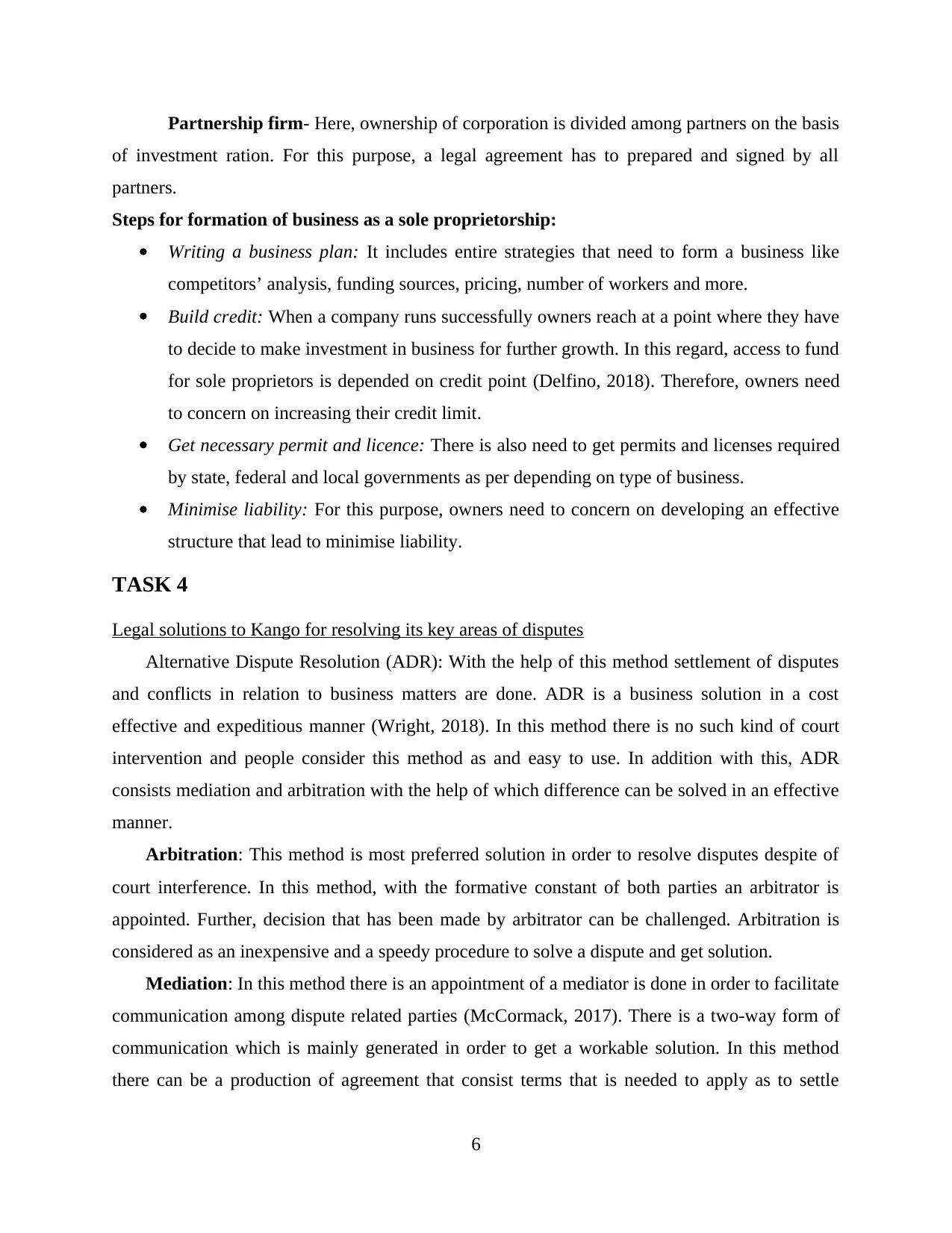
Partnership firm- Here, ownership of corporation is divided among partners on the basis
of investment ration. For this purpose, a legal agreement has to prepared and signed by all
partners.
Steps for formation of business as a sole proprietorship:
Writing a business plan: It includes entire strategies that need to form a business like
competitors’ analysis, funding sources, pricing, number of workers and more.
Build credit: When a company runs successfully owners reach at a point where they have
to decide to make investment in business for further growth. In this regard, access to fund
for sole proprietors is depended on credit point (Delfino, 2018). Therefore, owners need
to concern on increasing their credit limit.
Get necessary permit and licence: There is also need to get permits and licenses required
by state, federal and local governments as per depending on type of business.
Minimise liability: For this purpose, owners need to concern on developing an effective
structure that lead to minimise liability.
TASK 4
Legal solutions to Kango for resolving its key areas of disputes
Alternative Dispute Resolution (ADR): With the help of this method settlement of disputes
and conflicts in relation to business matters are done. ADR is a business solution in a cost
effective and expeditious manner (Wright, 2018). In this method there is no such kind of court
intervention and people consider this method as and easy to use. In addition with this, ADR
consists mediation and arbitration with the help of which difference can be solved in an effective
manner.
Arbitration: This method is most preferred solution in order to resolve disputes despite of
court interference. In this method, with the formative constant of both parties an arbitrator is
appointed. Further, decision that has been made by arbitrator can be challenged. Arbitration is
considered as an inexpensive and a speedy procedure to solve a dispute and get solution.
Mediation: In this method there is an appointment of a mediator is done in order to facilitate
communication among dispute related parties (McCormack, 2017). There is a two-way form of
communication which is mainly generated in order to get a workable solution. In this method
there can be a production of agreement that consist terms that is needed to apply as to settle
6
of investment ration. For this purpose, a legal agreement has to prepared and signed by all
partners.
Steps for formation of business as a sole proprietorship:
Writing a business plan: It includes entire strategies that need to form a business like
competitors’ analysis, funding sources, pricing, number of workers and more.
Build credit: When a company runs successfully owners reach at a point where they have
to decide to make investment in business for further growth. In this regard, access to fund
for sole proprietors is depended on credit point (Delfino, 2018). Therefore, owners need
to concern on increasing their credit limit.
Get necessary permit and licence: There is also need to get permits and licenses required
by state, federal and local governments as per depending on type of business.
Minimise liability: For this purpose, owners need to concern on developing an effective
structure that lead to minimise liability.
TASK 4
Legal solutions to Kango for resolving its key areas of disputes
Alternative Dispute Resolution (ADR): With the help of this method settlement of disputes
and conflicts in relation to business matters are done. ADR is a business solution in a cost
effective and expeditious manner (Wright, 2018). In this method there is no such kind of court
intervention and people consider this method as and easy to use. In addition with this, ADR
consists mediation and arbitration with the help of which difference can be solved in an effective
manner.
Arbitration: This method is most preferred solution in order to resolve disputes despite of
court interference. In this method, with the formative constant of both parties an arbitrator is
appointed. Further, decision that has been made by arbitrator can be challenged. Arbitration is
considered as an inexpensive and a speedy procedure to solve a dispute and get solution.
Mediation: In this method there is an appointment of a mediator is done in order to facilitate
communication among dispute related parties (McCormack, 2017). There is a two-way form of
communication which is mainly generated in order to get a workable solution. In this method
there can be a production of agreement that consist terms that is needed to apply as to settle
6
⊘ This is a preview!⊘
Do you want full access?
Subscribe today to unlock all pages.

Trusted by 1+ million students worldwide
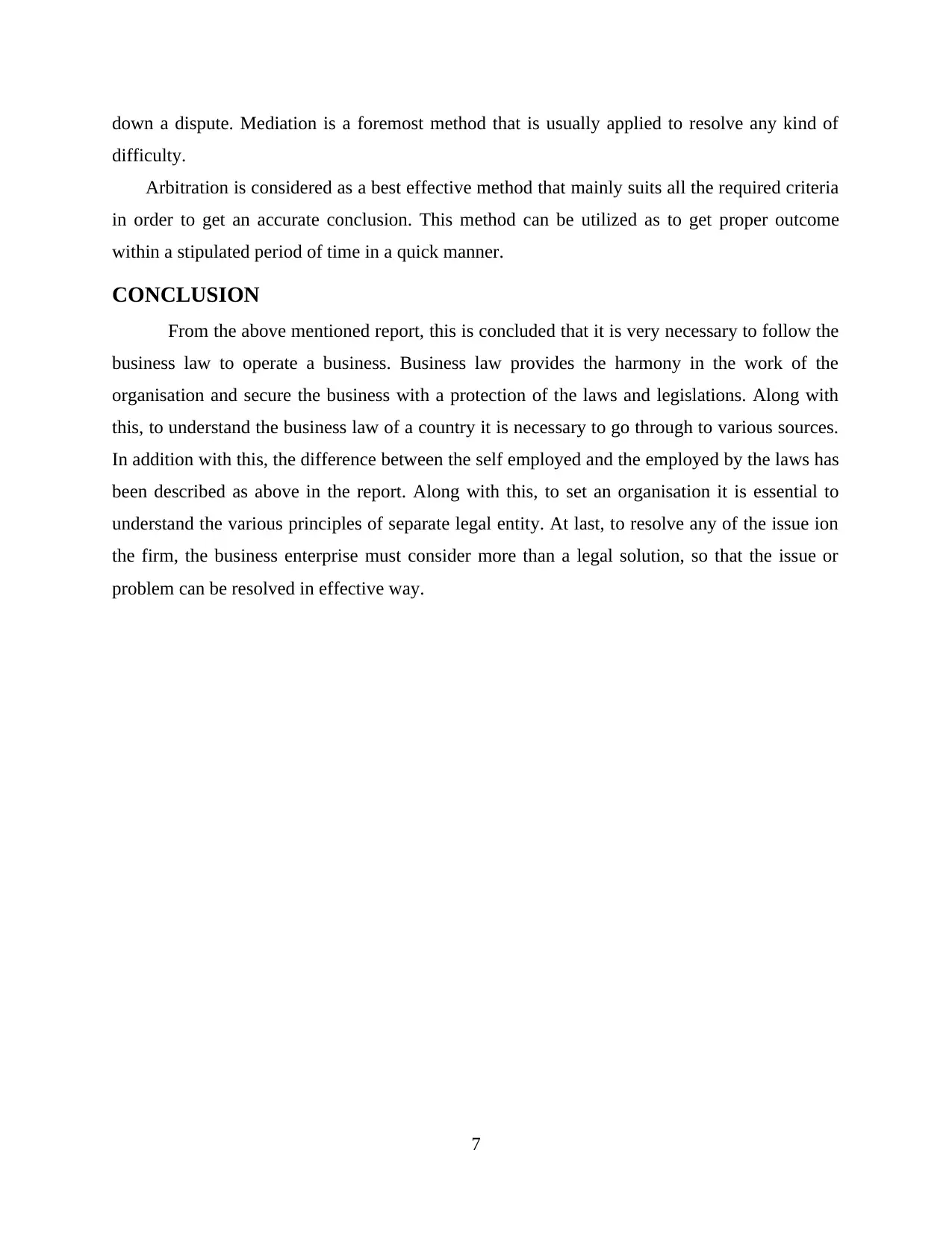
down a dispute. Mediation is a foremost method that is usually applied to resolve any kind of
difficulty.
Arbitration is considered as a best effective method that mainly suits all the required criteria
in order to get an accurate conclusion. This method can be utilized as to get proper outcome
within a stipulated period of time in a quick manner.
CONCLUSION
From the above mentioned report, this is concluded that it is very necessary to follow the
business law to operate a business. Business law provides the harmony in the work of the
organisation and secure the business with a protection of the laws and legislations. Along with
this, to understand the business law of a country it is necessary to go through to various sources.
In addition with this, the difference between the self employed and the employed by the laws has
been described as above in the report. Along with this, to set an organisation it is essential to
understand the various principles of separate legal entity. At last, to resolve any of the issue ion
the firm, the business enterprise must consider more than a legal solution, so that the issue or
problem can be resolved in effective way.
7
difficulty.
Arbitration is considered as a best effective method that mainly suits all the required criteria
in order to get an accurate conclusion. This method can be utilized as to get proper outcome
within a stipulated period of time in a quick manner.
CONCLUSION
From the above mentioned report, this is concluded that it is very necessary to follow the
business law to operate a business. Business law provides the harmony in the work of the
organisation and secure the business with a protection of the laws and legislations. Along with
this, to understand the business law of a country it is necessary to go through to various sources.
In addition with this, the difference between the self employed and the employed by the laws has
been described as above in the report. Along with this, to set an organisation it is essential to
understand the various principles of separate legal entity. At last, to resolve any of the issue ion
the firm, the business enterprise must consider more than a legal solution, so that the issue or
problem can be resolved in effective way.
7
Paraphrase This Document
Need a fresh take? Get an instant paraphrase of this document with our AI Paraphraser
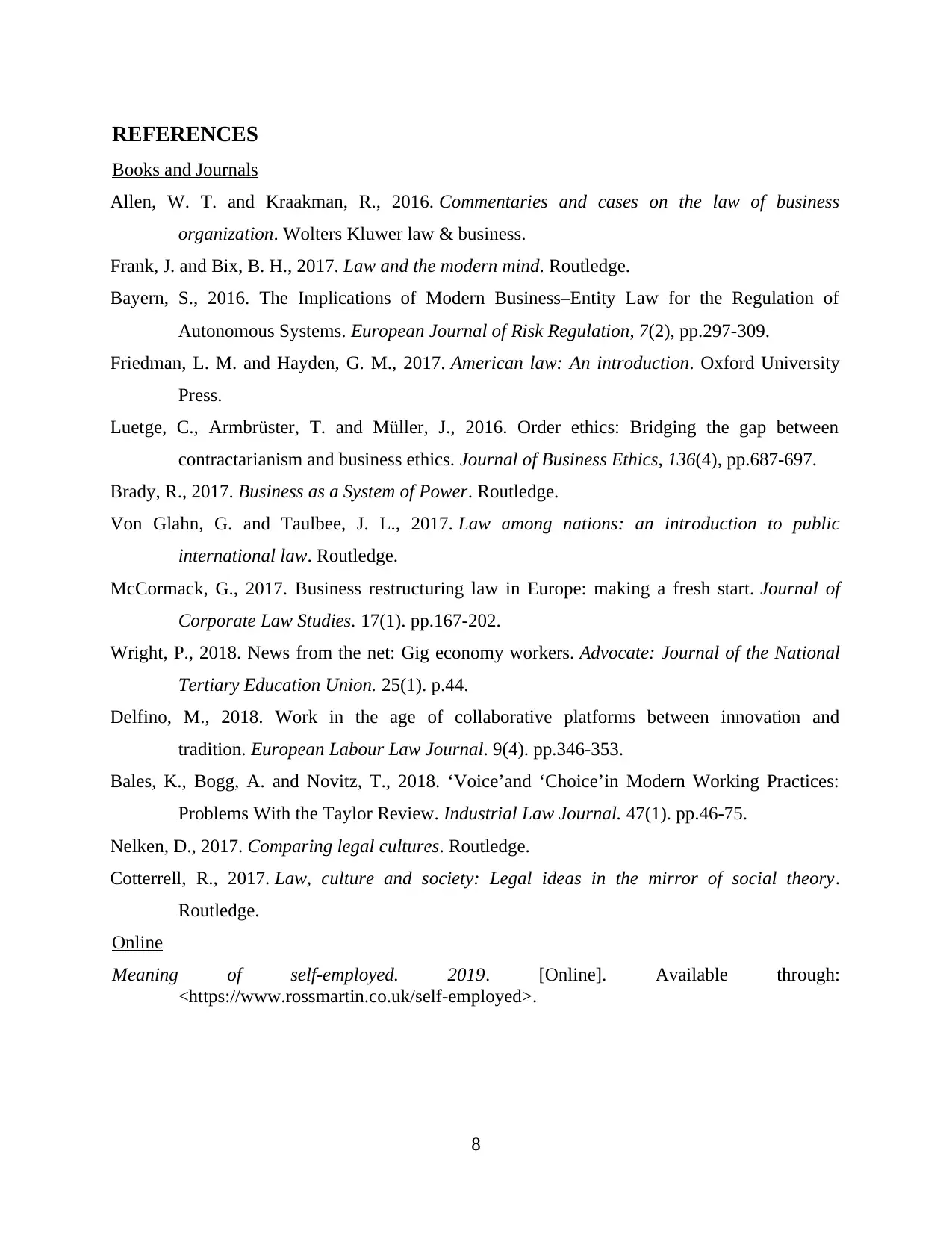
REFERENCES
Books and Journals
Allen, W. T. and Kraakman, R., 2016. Commentaries and cases on the law of business
organization. Wolters Kluwer law & business.
Frank, J. and Bix, B. H., 2017. Law and the modern mind. Routledge.
Bayern, S., 2016. The Implications of Modern Business–Entity Law for the Regulation of
Autonomous Systems. European Journal of Risk Regulation, 7(2), pp.297-309.
Friedman, L. M. and Hayden, G. M., 2017. American law: An introduction. Oxford University
Press.
Luetge, C., Armbrüster, T. and Müller, J., 2016. Order ethics: Bridging the gap between
contractarianism and business ethics. Journal of Business Ethics, 136(4), pp.687-697.
Brady, R., 2017. Business as a System of Power. Routledge.
Von Glahn, G. and Taulbee, J. L., 2017. Law among nations: an introduction to public
international law. Routledge.
McCormack, G., 2017. Business restructuring law in Europe: making a fresh start. Journal of
Corporate Law Studies. 17(1). pp.167-202.
Wright, P., 2018. News from the net: Gig economy workers. Advocate: Journal of the National
Tertiary Education Union. 25(1). p.44.
Delfino, M., 2018. Work in the age of collaborative platforms between innovation and
tradition. European Labour Law Journal. 9(4). pp.346-353.
Bales, K., Bogg, A. and Novitz, T., 2018. ‘Voice’and ‘Choice’in Modern Working Practices:
Problems With the Taylor Review. Industrial Law Journal. 47(1). pp.46-75.
Nelken, D., 2017. Comparing legal cultures. Routledge.
Cotterrell, R., 2017. Law, culture and society: Legal ideas in the mirror of social theory.
Routledge.
Online
Meaning of self-employed. 2019. [Online]. Available through:
<https://www.rossmartin.co.uk/self-employed>.
8
Books and Journals
Allen, W. T. and Kraakman, R., 2016. Commentaries and cases on the law of business
organization. Wolters Kluwer law & business.
Frank, J. and Bix, B. H., 2017. Law and the modern mind. Routledge.
Bayern, S., 2016. The Implications of Modern Business–Entity Law for the Regulation of
Autonomous Systems. European Journal of Risk Regulation, 7(2), pp.297-309.
Friedman, L. M. and Hayden, G. M., 2017. American law: An introduction. Oxford University
Press.
Luetge, C., Armbrüster, T. and Müller, J., 2016. Order ethics: Bridging the gap between
contractarianism and business ethics. Journal of Business Ethics, 136(4), pp.687-697.
Brady, R., 2017. Business as a System of Power. Routledge.
Von Glahn, G. and Taulbee, J. L., 2017. Law among nations: an introduction to public
international law. Routledge.
McCormack, G., 2017. Business restructuring law in Europe: making a fresh start. Journal of
Corporate Law Studies. 17(1). pp.167-202.
Wright, P., 2018. News from the net: Gig economy workers. Advocate: Journal of the National
Tertiary Education Union. 25(1). p.44.
Delfino, M., 2018. Work in the age of collaborative platforms between innovation and
tradition. European Labour Law Journal. 9(4). pp.346-353.
Bales, K., Bogg, A. and Novitz, T., 2018. ‘Voice’and ‘Choice’in Modern Working Practices:
Problems With the Taylor Review. Industrial Law Journal. 47(1). pp.46-75.
Nelken, D., 2017. Comparing legal cultures. Routledge.
Cotterrell, R., 2017. Law, culture and society: Legal ideas in the mirror of social theory.
Routledge.
Online
Meaning of self-employed. 2019. [Online]. Available through:
<https://www.rossmartin.co.uk/self-employed>.
8

9
⊘ This is a preview!⊘
Do you want full access?
Subscribe today to unlock all pages.

Trusted by 1+ million students worldwide
1 out of 12
Related Documents
Your All-in-One AI-Powered Toolkit for Academic Success.
+13062052269
info@desklib.com
Available 24*7 on WhatsApp / Email
![[object Object]](/_next/static/media/star-bottom.7253800d.svg)
Unlock your academic potential
Copyright © 2020–2025 A2Z Services. All Rights Reserved. Developed and managed by ZUCOL.



